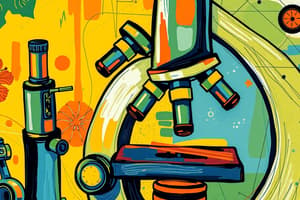Podcast
Questions and Answers
What does a hydraulic system use to move loads?
What does a hydraulic system use to move loads?
- Oil (correct)
- Electricity
- Water
- Air under pressure
In the context of pressure and area, what effect does a smaller area have on pressure?
In the context of pressure and area, what effect does a smaller area have on pressure?
- Doubles the pressure
- Decreases pressure
- Increases pressure (correct)
- No effect on pressure
According to Pascal's Law, how does an enclosed fluid transmit pressure?
According to Pascal's Law, how does an enclosed fluid transmit pressure?
- In the direction of gravity
- Equally in all directions (correct)
- In one direction only
- Opposite to the applied force
What is the unit for force as mentioned in the text?
What is the unit for force as mentioned in the text?
What is the mechanical advantage created by hydraulics due to?
What is the mechanical advantage created by hydraulics due to?
What is the area of P2 in the context of total force exerted?
What is the area of P2 in the context of total force exerted?
What is the total force exerted on P1?
What is the total force exerted on P1?
What does a pneumatic system use to move loads?
What does a pneumatic system use to move loads?
What is the unit for pressure as stated in the text?
What is the unit for pressure as stated in the text?
What does hydraulics increase in machines according to the text?
What does hydraulics increase in machines according to the text?
Flashcards are hidden until you start studying
Study Notes
Gears
- A pair of wheels with teeth that interlink, transferring turning motion and force to each other.
- Characteristics of gears:
- Work together in gear trains (2 or more gears)
- Can change the speed, force, and direction of motion
- Alternate the direction of spin
- Integrate with other gears, or with a linkage (e.g., sprockets)
Multiplying and Reducing Gears
- Multiplying gears: larger driving gear increases turning speed in the system
- Reducing gears: smaller driving gear decreases turning speed in the system
Mechanical Advantage (MA)
- Calculated as output force (load) / input force (force you apply)
- MA = 1 (no mechanical advantage) when input force equals output force
- Example: Justin uses a wheelbarrow to move 600 N bricks with 120 N (MA = 5)
Mechanical Advantage (MA) of Pulleys
- MA = number of pulleys in the system
- Diameter of pulleys does not affect MA
Mechanical Advantage (MA) of Screws
- MA = π (diameter of screw head) / lead (distance of one full rotation)
- Example: MA of a screw with 9mm radius and 3mm pitch is approximately 14.4
Mechanical Advantage (MA) of Inclined Planes
- MA = length of slope / height of the slope
- Example: MA of a screw with 9mm radius and 3mm pitch is approximately 3
Mechanical Advantage (MA) of Gears/Gear Trains
- MA = gear ratio (GR) = number of teeth of driven gear / number of teeth of driver gear
- Example: MA of a gear train with 30 teeth and 20 teeth is approximately 1.5
Mechanical Advantage (MA) of Other Simple Machines
- Speed ratio measures how the speed of an object is affected by a machine
- Example: inclined plane makes it possible to lift heavy objects using a smaller force, but requires moving the object over a longer distance
The Effects of Friction on MA
- Friction can reduce the efficiency of a machine and decrease MA
- One way to reduce friction is to lubricate the machine's moving parts
Calculating Pressure
- Pressure = force / area
- Example: pressure on a man's foot when a woman steps on his foot with her heel is approximately 520,000 Pa (Pascals)
Pressure in Fluids
- Hydraulic system uses a liquid under pressure to move loads
- Pneumatic system uses air under pressure to move loads
- Pascal's Law states that an enclosed fluid transmits pressure equally in all directions
Hydraulic Advantage
- Hydraulic system creates a mechanical advantage as a result of Pascal's Law on pressure
- MA is force multiplied throughout the system
Studying That Suits You
Use AI to generate personalized quizzes and flashcards to suit your learning preferences.




